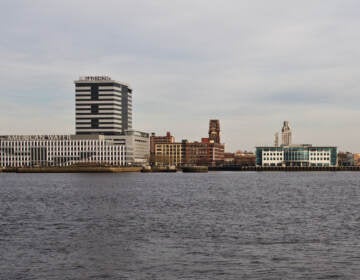New stormwater basin reduces flows into Philadelphia sewer system
The new facility will capture 60 million gallons a year of runoff from 20 commercial properties in Northeast Philadelphia.

A new storm water basin in Northeast Philadelphia will reduce runoff into the city's sewer system. (StateImpact Pennsylvania)
Philadelphia’s long-running efforts to control its stormwater flows took a step forward Thursday with the official opening of a facility that will capture 60 million gallons a year of runoff from 20 commercial properties in Northeast Philadelphia.
The 40-acre site in the Red Lion Industrial District now has two retention basins that collect storm water from nearby businesses that would otherwise have become runoff. Without the basins, runoff pollution from streets and parking lots would have contaminated the local Pennypack watershed.
The project was funded with a $1.6 million stormwater grant from Philadelphia Water Department. It’s one of the largest of its kind in the city’s 25-year Green City Clean Water campaign.
“We’re required by the Clean Water Act to reduce the volume of combined sewer overflows into our waterways, and this project is capturing millions of gallons of water a year to help us do that,” said Debra McCarty, commissioner of PWD.
She said the project brings together the efforts of PWD and the City of Philadelphia with the businesses whose stormwater flows are diverted and a contractor, Infrastructure Solution Services, which created the stormwater basin.
The contractor “is working with those businesses to combine their resources and have one system that manages stormwater for the area,” she said.
Participating companies get a reduction in the stormwater portion of their water bills, which are calculated from the pervious and impervious areas of their properties, McCarty said. With the diversion of water into the new basin, businesses save money on their stormwater bills.
“If it’s not getting into our system, they can get a reduction in the fee because our system isn’t burdened with that runoff,” she said.
The site, at Sandmeyer Lane, was first identified in 2012 as a potential place for regional stormwater management by the City of Philadelphia and the Philadelphia Industrial Development Corporation.
The initial plan didn’t work because the business owners couldn’t agree on a plan to buy the site and commit to a plan for construction and maintenance.
But Infrastructure Solution Services advanced the project by buying the site, and it obtained the PWD funds through its Stormwater Management Incentives Program. As a result, the businesses no longer had the responsibility of building or maintaining the facility. The basin is designed to provide infiltration for a 1-inch rainstorm and detention of water for up to 100-year storms.
Creation of the basin took some 18 months and required moving more than 60,000 cubic yards of soil, officials said. Some trees were removed, but they will be replaced by more than 900 plantings. The project uses shredded tires packaged in mesh crates as a substitute for stone aggregate in the bottom of the basins. Before use, the tires are washed to remove contaminants such as grease and gasoline.
Ken Curry, chief operating officer of Infrastructure Solution Services, said the reduction in stormwater flow will make it less likely that city officials will have to release a combination of stormwater and sewage – known as combined sewer overflows — into waterways, as they are permitted to do during heavy storms to prevent sewage from backing up into residences.
“By holding back a 1-inch or 1½-inch rain storm, it prevents that overwhelming of the system and less likelihood for these valves to be open, causing contamination and pollution to the environment,” he said.
Mike DiBerardinis, Philadelphia’s managing director, said at a ribbon-cutting ceremony that the project helps both the environment and the surrounding businesses, and it should become an example for future projects to enhance the city’s leadership nationally and internationally in stormwater management.
Philadelphia Councilman Brian O’Neill said PWD has become a “problem solver” for businesses that have been required to pay the stormwater fee, and he highlighted the new basin as the latest example of that.
WHYY is your source for fact-based, in-depth journalism and information. As a nonprofit organization, we rely on financial support from readers like you. Please give today.




